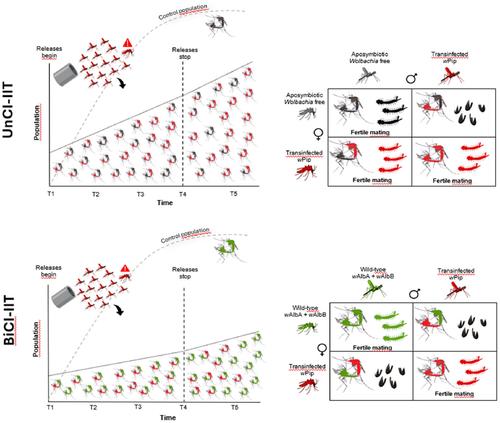当前位置:
X-MOL 学术
›
Pest Manag. Sci.
›
论文详情
Our official English website, www.x-mol.net, welcomes your feedback! (Note: you will need to create a separate account there.)
Incompatible insect technique: insights on potential outcomes of releasing contaminant females: a proof of concept under semi‐field conditions
Pest Management Science ( IF 3.8 ) Pub Date : 2024-06-21 , DOI: 10.1002/ps.8263 Giulia Lombardi 1, 2 , Elena Lampazzi 1 , Maurizio Calvitti 1
Pest Management Science ( IF 3.8 ) Pub Date : 2024-06-21 , DOI: 10.1002/ps.8263 Giulia Lombardi 1, 2 , Elena Lampazzi 1 , Maurizio Calvitti 1
Affiliation

|
BACKGROUNDReleasing large numbers of Aedes albopictus males, carrying the artificially introduced Wolbachia ‘w Pip’ strain, results in a decrease in the reproductive capacity of wild females due to a phenomenon known as cytoplasmic incompatibility (CI). This vector control strategy is referred to as the incompatible insect technique (IIT). However, its widespread implementation faces various challenges, including the complexity of removing fertile females from the males intended for release. Here, we present the results of semi‐field experiments comparing the impact of minimal female co‐release on two IIT modes: unidirectional CI‐based (UnCI IIT) and bidirectional CI‐based (BiCI IIT), specifically targeting Ae. albopictus .RESULTSThe contamination of ‘w Pip’ infected females (2%) during male releases significantly weakened the overall effectiveness of IIT, emphasizing the need for thorough sex separation. Specifically, with UnCI IIT, despite the low rate of co‐released females, there was a gradual rise in ‘w Pip’ infection frequency, resulting in more compatible mating and subsequently higher rates of egg hatching. Conversely, this pattern was effectively mitigated in BiCI IIT owing to the reciprocal sterility between the wild‐type and the ‘w Pip’ infected populations.CONCLUSIONThrough an experimental approach, conducted in a semi‐field setting, we have contributed to advancing scientific understanding regarding the potential outcomes of implementing the IIT strategy in the absence of a complete sexing system. The results suggest that safety measures for mitigating the potential impacts of co‐released females can be tailored according to the specific type of IIT being utilized. © 2024 Society of Chemical Industry.
中文翻译:

不相容昆虫技术:关于释放污染雌虫的潜在结果的见解:半田间条件下的概念证明
背景释放大量携带人工引入的沃尔巴克氏菌“wPip”菌株的白纹伊蚊雄性,会由于细胞质不相容(CI)现象而导致野生雌性的繁殖能力下降。这种病媒控制策略被称为不相容昆虫技术(IIT)。然而,其广泛实施面临着各种挑战,包括从打算释放的雄性中去除具有生育能力的雌性的复杂性。在这里,我们展示了半现场实验的结果,比较了最小雌性共同释放对两种 IIT 模式的影响:基于单向 CI (UnCI IIT) 和基于双向 CI (BiCI IIT),专门针对 Ae。结果在雄性释放过程中感染“wPip”的雌性(2%)受到污染,显着削弱了 IIT 的整体效果,强调了彻底性别隔离的必要性。具体来说,在 UnCI IIT 中,尽管共同释放雌性的比例较低,但“wPip”感染频率逐渐上升,导致交配更加相容,从而提高了卵孵化率。相反,由于野生型和“wPip”感染群体之间的相互不育性,这种模式在 BiCI IIT 中得到了有效缓解。结论通过在半田间环境中进行的实验方法,我们为推进对这一问题的科学理解做出了贡献。在缺乏完整的性别系统的情况下实施个人所得税战略的潜在结果。结果表明,可以根据所使用的 IIT 的具体类型来制定减轻共同释放女性潜在影响的安全措施。 © 2024 化学工业协会。
更新日期:2024-06-21
中文翻译:

不相容昆虫技术:关于释放污染雌虫的潜在结果的见解:半田间条件下的概念证明
背景释放大量携带人工引入的沃尔巴克氏菌“wPip”菌株的白纹伊蚊雄性,会由于细胞质不相容(CI)现象而导致野生雌性的繁殖能力下降。这种病媒控制策略被称为不相容昆虫技术(IIT)。然而,其广泛实施面临着各种挑战,包括从打算释放的雄性中去除具有生育能力的雌性的复杂性。在这里,我们展示了半现场实验的结果,比较了最小雌性共同释放对两种 IIT 模式的影响:基于单向 CI (UnCI IIT) 和基于双向 CI (BiCI IIT),专门针对 Ae。结果在雄性释放过程中感染“wPip”的雌性(2%)受到污染,显着削弱了 IIT 的整体效果,强调了彻底性别隔离的必要性。具体来说,在 UnCI IIT 中,尽管共同释放雌性的比例较低,但“wPip”感染频率逐渐上升,导致交配更加相容,从而提高了卵孵化率。相反,由于野生型和“wPip”感染群体之间的相互不育性,这种模式在 BiCI IIT 中得到了有效缓解。结论通过在半田间环境中进行的实验方法,我们为推进对这一问题的科学理解做出了贡献。在缺乏完整的性别系统的情况下实施个人所得税战略的潜在结果。结果表明,可以根据所使用的 IIT 的具体类型来制定减轻共同释放女性潜在影响的安全措施。 © 2024 化学工业协会。











































 京公网安备 11010802027423号
京公网安备 11010802027423号